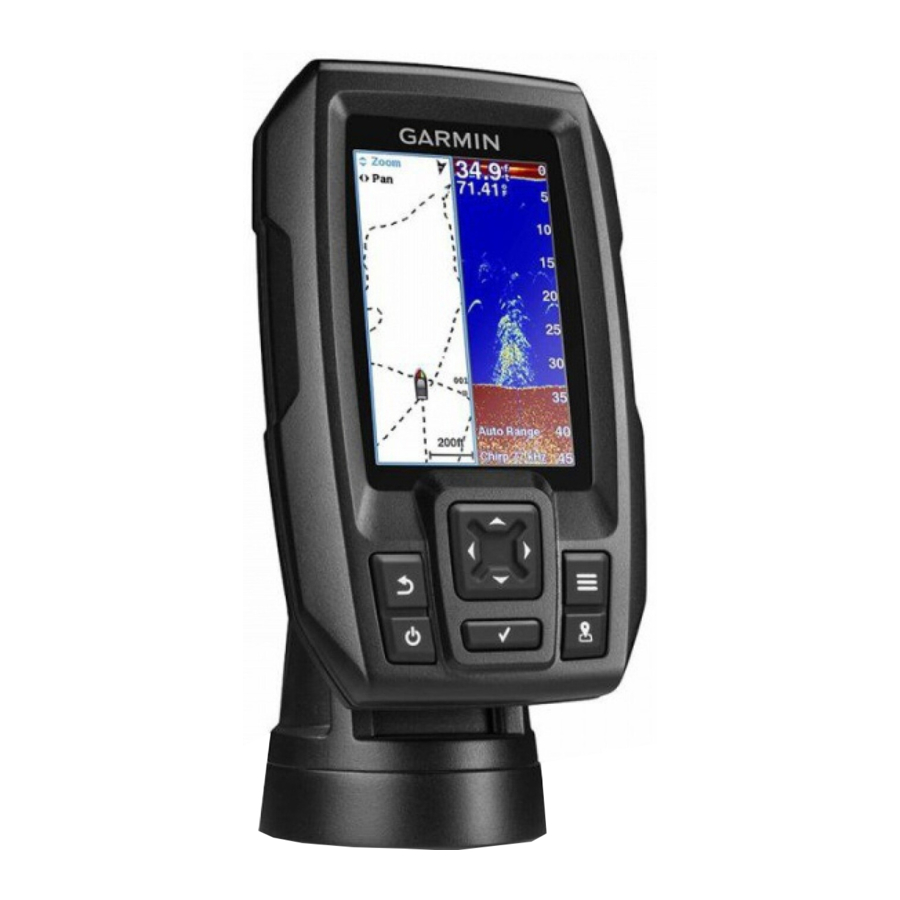
Garmin Striker 4 Manual
- Owner's manual (11 pages) ,
- Quick start manual (2 pages) ,
- Installation instructions manual (19 pages)
Advertisement
- 1 Introduction
- 2 Home Screen
-
3
Sonar
- 3.1 Full Screen Sonar
- 3.2 Garmin ClearVü Sonar View
- 3.3 SideVü Sonar View
- 3.4 Split-Screen Frequency
- 3.5 Flasher
- 3.6 Split-Zoom View
- 3.7 Pausing the Sonar
- 3.8 Creating a Waypoint on the Sonar Screen Using Your Present Location
- 3.9 Creating a Waypoint on the Sonar Screen Using a Different Location
- 3.10 Adjusting the Zoom
- 3.11 Sonar Frequencies
- 3.12 Sonar Gain
- 3.13 Adjusting the Range of the Depth Scale
- 3.14 Sonar Setup
-
4
Waypoints
- 4.1 Marking Your Present Location as a Waypoint
- 4.2 Creating a Waypoint at a Different Location
- 4.3 Editing a Saved Waypoint
- 4.4 Marking and Navigating to a Man Overboard Location
- 4.5 Navigating to a Waypoint
- 4.6 Measuring Distance on the Waypoint Map
- 4.7 Deleting a Waypoint or an MOB
- 4.8 Deleting All Waypoints
- 4.9 Sharing Waypoints and Routes Across Devices
- 4.10 Waypoint Map Settings
- 5 Routes
- 6 Track
- 7 Device Configuration
- 8 Registering Your Device
- 9 Specifications
- 10 Troubleshooting
- 11 Videos
- 12 Documents / Resources

Introduction
See the Important Safety and Product Information guide in the product box for product warnings and other important information.
Device Overview
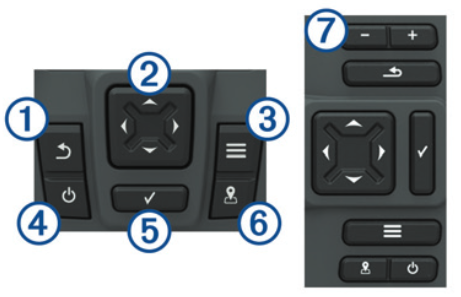
| 1 |  | Returns to the previous screen. Returns to the home screen when held. |
| 2 |  | Scrolls, highlights options, and moves the cursor. Zooms in and out of a view. (Available only on the 4 in. models.) |
| 3 |  | Closes a menu, when applicable. Opens a menu of options for the page, when applicable. |
| 4 |  | Turns on and off the device when held. Performs one or more of these actions when quickly press and release:
|
| 5 |  | Acknowledges messages and selects options. |
| 6 |  | Saves the present location as a waypoint. |
7 |  | Zooms out of a view. (Available only on the 5 in. and 7 in. models.) |
 | Zooms in to a view. (Available only on the 5 in. and 7 in. models.) |
Selecting the Transducer Type
If you are connecting a transducer that was not included with the chartplotter, you may need to set the transducer type to make the sonar function properly. If the device automatically detected your transducer, this option does not appear.
This chartplotter is compatible with the Garmin ClearVü™ transducer as well as a range of accessory transducers including Garmin GT transducers.
- Select Settings > My Vessel > Transducer Type.
- Select the type of transducer you are using.
Zooming on the STRIKER 4
You can zoom in and out of the Waypoint Map.
- Select
![]() to zoom in.
to zoom in. - Select
![]() to zoom out.
to zoom out.
Panning on the STRIKER 4
You can move the Waypoint Map to view an area other than your present location.
- Select
![]() or
or ![]() to start panning.
to start panning. - Use the arrow keys to pan.
TIP: You can select ![]() to zoom.
to zoom.
Adjusting the Backlight
- Select Settings > System > Display > Backlight.
TIP: Press![]() from any screen to open the backlight settings.
from any screen to open the backlight settings. - Adjust the backlight.
Adjusting the Color Mode
- Select Settings > System > Display > Color Mode.
TIP: Press![]() from any screen to access the color settings.
from any screen to access the color settings. - Select an option.
Setting the Beeper
You can set when the device makes sounds.
- Select Settings > System > Beeper.
- Select an option:
- To have the device beep when you select an item and when an alarm is triggered, select On (Selections and Alarms).
- To have the device beep only when alarms are triggered, select Alarms Only.
GPS Satellite Signal Acquisition
When you turn on the fishfinder, the GPS receiver must collect satellite data and establish the current location. When the fishfinder acquires satellite signals,  appears at the top of the Home screen. When the fishfinder loses satellite signals,
appears at the top of the Home screen. When the fishfinder loses satellite signals,  disappears and a flashing question mark appears over
disappears and a flashing question mark appears over ![]() on the screen.
on the screen.
Home Screen
The fishfinder home screen provides access to all of the features in the fishfinder. The features are dependant on the accessories you have connected to the fishfinder. You may not have all of the options and features discussed in this manual.
When viewing another screen, you can return to the home screen by holding ![]() . You can customize the layout of the screens.
. You can customize the layout of the screens.
Customizing the Home Screen
You can add items to and rearrange items on the Home screen.
- From the Home screen, select Customize Home.
- Select an option:
- To rearrange an item, select Rearrange, select the item to move, and select the new location.
- To add an item to the Home screen, select Add, and select the new item.
- To remove an item you have added to the Home screen, select Remove, and select the item.
Adding a New Layout to the Home Screen of the STRIKER 5 or 7
You can create a custom screen to suit your needs, which is added to your home screen.
- Select Customize Home > Add > Add New Layout.
- Select a function layout.
- Select a window to change.
- Select a screen to add.
- Repeat steps 3 and 4 for additional windows.
- Select Data (Hidden) (optional).
- Select an option:
- To customize the data shown on the screen, select Overlay Numbers.
- To turn on and off the compass tape data bar, select Compass Tape.
- Select Next.
- Enter a name for the combination.
TIP:
- Select
![]() to save.
to save. - Hold
![]() to clear data.
to clear data. - Select + or - to change letter case.
- Use the arrow keys to resize the windows.
- Use the arrow keys to select a home screen location.
Adding a Custom Layout to the Home Screen of the STRIKER 4
You can create a custom screen to suit your needs, which is added to your home screen.
- Select Customize Home > Add > Add New Layout.
- Select the first function to add.
- Select the second function to add.
- Select Split to choose the direction of the split screens (optional).
- Select Next.
- Enter a name for the combination.
TIP:
- Select
![]() to save.
to save. - Select
![]() to change letter case.
to change letter case. - Hold
![]() to clear data.
to clear data.
- Use the arrow keys to resize the windows.
- Use the arrow keys to select a home screen location.
Adding the Numbers Screen
Before you can customize the Numbers screen, you must add it to the home screen.
You can view numeric data on the home screen using the Numbers screen.
Select Customize Home > Add > Numbers.
Numbers
To customize the Numbers screen, select Numbers > ![]() .
.
Change Numbers: Sets what type of number data is displayed.
Change Layout: Sets the amount of number data that is displayed.
Reset Trip: Resets the trip data and allows you to record new trip data.
Reset Odometer: Resets the odometer data and allows you to record new odometer data.
Reset Maximum Speed: Resets the maximum speed for the trip and allows your to record a new maximum speed.
Adding the Data Graphs Screen
Before you can customize the Data Graphs screen, you must add it to the home screen.
You can view graphical sonar data on the home screen using the Data Graphs screen.
From the home screen, select Customize Home > Add > Data Graphs.
Data Graphs
To customize the Data Graphs screen, select Data Graphs > ![]() .
.
Change Graph: Sets the type of data displayed on the screen.
Depth Graph Settings: Sets the amount of time and the range of depth that appear in the depth graphs.
Temperature Graph Settings: Sets the amount of time and the range of depth that appear in the temperature graphs.
Sonar
The full screen page, the split frequency page, and the flasher page are visual representations of the area beneath your boat. You can customize these sonar views.
NOTE: Not all devices have these features.
Full Screen Sonar
You can see a full-view graph of sonar readings from a transducer on the full screen.
Select Traditional or ClearVü.

| 1 | Bottom depth |
| 2 | Water temperature |
| 3 | GPS speed |
| 4 | Device voltage |
| 5 | Time |
| 6 | Transducer type and frequency |
| 7 | Suspended targets (fish) |
| 8 | Depth indicator as the sonar data the screen scrolls from right to left |
Garmin ClearVü Sonar View
NOTE: Not all models support Garmin ClearVü sonar technology and transducers.
NOTE: To receive Garmin ClearVü scanning sonar, you need a compatible fishfinder and a compatible transducer.
Garmin ClearVü high-frequency sonar provides a detailed picture of the fishing environment around the boat in a detailed representation of structures the boat is passing over.
Traditional transducers emit a conical beam. The Garmin ClearVü scanning sonar technology emits two narrow beams, similar to the shape of the beam in a copying machine. These beams provide a clearer, picture-like image of what is around the boat.
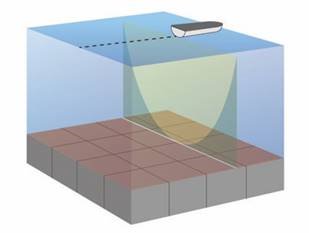
SideVü Sonar View
NOTE: Not all models support SideVü sonar and scanning transducers.
NOTE: To receive SideVü scanning sonar, you need a compatible transducer and fishfinder.
SideVü scanning sonar technology shows you a picture of what lies to the sides of the boat. You can use this as a search tool to find structures and fish.

| 1 | Left side of the vessel |
| 2 | Right side of the vessel |
| 3 | The transducer on your vessel |
| 4 | Trees |
| 5 | Old tires |
| 6 | Logs |
| 7 | Distance from the side of the vessel |
| 8 | Water between the vessel and the bottom |
Split-Screen Frequency
You can view two frequencies from the split frequency screen.

Flasher
The flasher shows sonar information on a circular depth scale, indicating what is beneath your boat. It is organized as a ring that starts at the top and progresses clockwise. Depth is indicated by the scale inside the ring. Sonar information flashes on the ring when it is received at the depth indicated. The colors indicate different strengths of the sonar return.
Select Flasher.

| 1 | Depth at your present location |
| 2 | Depth scale |
Split-Zoom View
On the split-zoom page, you can see a full-view graph of sonar readings on the right side of the screen, and a magnified portion of that graph on the left side of the screen.
From a sonar screen, select > Split Zoom.
> Split Zoom.
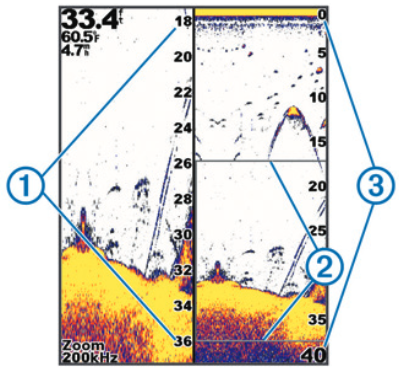
| 1 | Zoomed depth scale |
| 2 | Zoom window |
| 3 | Depth range |
Pausing the Sonar
Not all options are available on all models.
Select an option:
- From the Traditional or ClearVü sonar screen, select
![]() or
or ![]() .
. - From the SideVü sonar screen, select
![]() or
or ![]() .
.
Creating a Waypoint on the Sonar Screen Using Your Present Location
- From a sonar view, select
![]() .
. - If necessary, edit the waypoint information.
Creating a Waypoint on the Sonar Screen Using a Different Location
- From a sonar view, pause the sonar.
- Select a location.
- Select
![]() .
. - If necessary, edit the waypoint information.
Adjusting the Zoom
You can adjust the zoom manually by specifying the span and a fixed starting depth. For example, when the depth is 15 m and the starting depth is 5 m, the device displays a magnified area from 5 to 20 m deep.
You also can allow the device to adjust the zoom automatically by specifying a span. The device calculates the zoom area from the bottom of the water. For example, if you select a span of 10 m, the device displays an magnified area from the bottom of the water to 10 m above the bottom.
- From a sonar screen, select
![]() > Zoom.
> Zoom. - Select an option:
- Select Bottom Lock to lock the screen to the water bottom.
- Select Manual to manually set the zoom.
- Select Auto to automatically set the zoom.
- Select Split Zoom to turn on the split-zoom view.
Locking the Screen to the Water Bottom
You can lock the screen to the water bottom. For example, if you select a span of 20 meters, the device shows an area from the water bottom to 20 meters above the bottom. The span appears on the right side.
- From a sonar view, select
![]() > Zoom > Bottom Lock.
> Zoom > Bottom Lock. - Select a span.
Sonar Frequencies
NOTE: The frequencies that are available depend on the transducer being used.
Adjusting the frequency helps adapt the sonar for your particular goals and the present depth of the water.
Selecting Frequencies
NOTE: You cannot adjust the frequency for all sonar views and transducers.
You can indicate which frequencies appear on the sonar screen.
- From a sonar view, select
![]() > Frequency.
> Frequency. - Select a frequency suited to your needs and water depth.
For more information on frequencies, see Sonar Frequencies.
Creating a Frequency Preset
NOTE: Not available with all transducers.
You can create a preset to save a specific sonar frequency, which allows you to change frequencies quickly.
- From a sonar view, select
![]() > Frequency.
> Frequency. - Select Add.
- Enter a frequency.
Sonar Gain
The gain setting controls the sensitivity of the sonar receiver to compensate for water depth and water clarity. Increasing the gain shows more detail, and decreasing the gain reduces screen clutter.
NOTE: Setting the gain on one sonar view applies the setting to all the views.
Setting the Gain Automatically
NOTE: To set the gain on the split-frequency screen, you must set each frequency separately.
- Select
![]() > Gain.
> Gain. - Select Enable Auto Gain, if applicable.
- Select an option:
- To display higher-sensitivity, weaker sonar returns with more noise automatically, select Auto High.
- To display medium-sensitivity sonar returns with moderate noise automatically, select Auto Med.
- To display lower-sensitivity sonar returns with less noise automatically, select Auto Low.
Setting the Gain Manually
- From a sonar screen, select
![]() > Gain.
> Gain. - Select
![]() or
or ![]() until you begin to see noise in the water portion of the screen.
until you begin to see noise in the water portion of the screen. - Select
![]() or
or ![]() to decrease the gain.
to decrease the gain.
Adjusting the Range of the Depth Scale
You can adjust the range of the depth scale that appears on the right side of the screen. Automatic ranging keeps the bottom within the lower third of the sonar screen, and can be useful for tracking the bottom where there are slow or moderate terrain changes.
When the depth changes dramatically, like a drop off or cliff, manually adjusting the range allows a view of a specified depth range. The bottom is shown on the screen as long as the bottom is anywhere within the manual range established.
- From a sonar screen, select
![]() > Range.
> Range. - Select an option:
- To allow the device to adjust the range automatically based on the depth, select Auto.
- To increase or decrease the range manually, select
![]() or
or ![]() . (Available only on the 5 in. and 7 in. models.)
. (Available only on the 5 in. and 7 in. models.) - To increase or decrease the range manually, select
![]() or
or ![]() . (Available only on the 4 in. models.)
. (Available only on the 4 in. models.)
NOTE: From a sonar screen, select + and - to quickly manually adjust the range. (Available only on the 5 in. and 7 in. models.)
From a sonar screen, select + and - to quickly resume auto range. (Available only on the 5 in. and 7 in. models.)
From a sonar screen, select  or
or  to quickly adjust the range. (Available only on the 4 in. models.)
to quickly adjust the range. (Available only on the 4 in. models.)
Setting the range on one screen applies that setting to all screens.
Sonar Setup
NOTE: Not all options and settings apply to all models and transducers.
Showing and Adjusting the Depth Line
You can show and adjust a horizontal line on a sonar screen.
The depth of the line is indicated on the right side of the screen.
NOTE: Showing a depth line on one screen displays the depth line on all the screens.
- From a sonar screen, select
![]() > Sonar Setup > Depth Line.
> Sonar Setup > Depth Line. - Select
![]() .
. - To adjust the Depth Line, select
![]() or
or ![]() .
.
Setting the Scroll Speed
You can set the rate at which the sonar image moves across the screen. A higher scroll speed shows more detail, especially while moving or trolling. A lower scroll speed displays sonar information on the screen longer. Setting the scroll speed on one sonar view applies to all the sonar views.
- From a sonar view, select
![]() > Sonar Setup > Scroll Speed.
> Sonar Setup > Scroll Speed. - Select an option:
- To adjust the scroll speed automatically using speed-overground, select Auto.
The Auto setting selects a scroll rate to match the boat speed, so targets in the water are drawn with the correct aspect ratio and appear less distorted. When viewing Garmin ClearVü or SideVü sonar views, it is recommend to use the Auto setting. - To use a very fast scroll speed, select Ultrascroll®.
The Ultrascroll option quickly scrolls new sonar data, but with a reduced image quality. For most situations, the Fast option provides a good balance between a quickly scrolling image and targets that are less distorted.
Setting the Bottom Search Limit
You can set a maximum depth at which the auto range feature searches for the bottom. A lower limit acquires data about the bottom faster than a higher limit.
- From a sonar screen, select
![]() > Sonar Setup > Bottom Search Limit.
> Sonar Setup > Bottom Search Limit. - Select a range.
Sonar Appearance Settings
From a sonar view, select ![]() > Sonar Setup > Appearance.
> Sonar Setup > Appearance.
Color Scheme: Sets the color scheme.
Edge: Highlights the strongest signal from the bottom to help define the hardness or softness of the signal.
A-Scope: Displays a vertical flasher along the right side of the screen that shows instantaneously the range to targets along a scale.
Fish Symbols: Sets how the sonar interprets suspended targets.
Turning on the A-Scope
The a-scope is a vertical flasher along the right side of the fullscreen sonar view. This feature expands the most recently received sonar data so that it is easier to see. It can also be helpful for detecting fish that are close to the bottom. NOTE: This feature is not available on all sonar screens.
From the full screen page, select  > Sonar Setup > Appearance > A-Scope.
> Sonar Setup > Appearance > A-Scope.
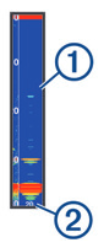
| 1 | A-Scope |
| 2 | Diameter of the sonar cone at the present depth |
Configuring the Appearance of Suspended Targets
NOTE: Configuring the appearance of suspended targets on one screen applies that setting to all screens.
NOTE: This feature is not available on all sonar views.
 | Shows suspended targets as symbols. |
 | Shows suspended targets as symbols with target depth information. |
 | Shows suspended targets as symbols with background sonar information. |
 | Shows suspended targets as symbols with background sonar information and target depth information. |
- From a sonar screen, select
![]() > Sonar Setup > Appearance > Fish Symbols.
> Sonar Setup > Appearance > Fish Symbols. - Select an option.
Sonar Noise Rejection Settings
From a sonar view, select ![]() > Sonar Setup > Noise Reject.
> Sonar Setup > Noise Reject.
Interference: Adjusts the sensitivity to reduce the effects of interference from nearby sources of noise.
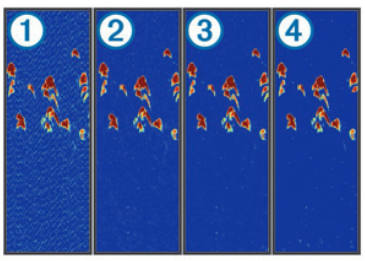
When you adjust the interference setting from off ![]() through low
through low ![]() , medium
, medium ![]() , and high
, and high ![]() , noise is gradually removed, but there is little effect on the strong target returns. You should use the lowest interference setting that achieves the desired improvement to remove interference from the screen. Correcting installation issues that cause noise is the best way to eliminate interference.
, noise is gradually removed, but there is little effect on the strong target returns. You should use the lowest interference setting that achieves the desired improvement to remove interference from the screen. Correcting installation issues that cause noise is the best way to eliminate interference.
Surface Noise: Hides sonar returns near the surface of the water. Hiding surface noise helps reduce screen clutter.

Surface noise  is caused by interference between the transducer and water. You can hide surface noise
is caused by interference between the transducer and water. You can hide surface noise to help reduce clutter. Wider beam widths (lower frequencies) can show more targets, but can generate more surface noise.
to help reduce clutter. Wider beam widths (lower frequencies) can show more targets, but can generate more surface noise.
TVG: Reduces surface noise.
This control is best used for situations when you want to control and suppress clutter or noise near the water surface. It also allows for the display of targets near the surface that are otherwise hidden or masked by surface noise.
Overlay Number Settings
You can customize the data shown on the sonar screen.
NOTE: Not all features are available on all devices.
From a sonar screen, select ![]() > Overlay Numbers.
> Overlay Numbers.
Navigation Inset: Shows the navigation inset when the vessel is navigating to a destination.
Device Voltage: Shows the voltage of the device.
Speed: Shows the vessel's current speed.
Time of Day: Shows the current time of day.
Compass Tape: Shows the compass tape data bar.
Depth: Shows the transducer's current depth.
Water Temp.: Shows the current water temperature.
Waypoints
Waypoints are locations you record and store in the device.
Marking Your Present Location as a Waypoint
From any screen, select  .
.
Creating a Waypoint at a Different Location
- Select User Data > Waypoints > New Waypoint.
- Select an option:
- To create the waypoint by entering position coordinates, select Enter Coordinates, and enter the coordinates.
- To create the waypoint using the waypoint map, select Use Waypoint Map, select the location, and select
![]() .
. - To create the waypoint using your present location, select Use Current Position, and enter the data.
The waypoint is saved automatically.
Editing a Saved Waypoint
- Select User Data > Waypoints.
- Select a waypoint.
- Select Edit Waypoint.
- Select an option:
- To add a name, select Name, and enter a name.
- To change the symbol, select Symbol.
- To change the depth, select Depth.
- To change the water temperature, select Water Temp..
- To change the comment, select Comment.
- To move the position of the waypoint, select Position.
Marking and Navigating to a Man Overboard Location
From any screen, select  > Man Overboard > Yes.
> Man Overboard > Yes.
The fishfinder sets a direct course back to the location.
Navigating to a Waypoint
- Pan the waypoint map to find the waypoint.
- Place the center of the cursor on the center of the waypoint symbol.
The waypoint name appears on the screen. - Select the waypoint.
- Select Navigate Route > Go To.
Measuring Distance on the Waypoint Map
You can measure the distance between two locations.
- From the waypoint map, begin panning (Panning on the STRIKER 4).
- Select
![]() > Measure Distance.
> Measure Distance.
The distance and other data appear on the screen.
Deleting a Waypoint or an MOB
- Select User Data > Waypoints.
- Select a waypoint or an MOB.
- Select Delete > OK.
Deleting All Waypoints
Select User Data > Manage Data > Clear User Data > Waypoints > All.
Sharing Waypoints and Routes Across Devices
Before you can share waypoints and routes, you must connect the blue and brown wires on the power cable.
The blue wire is for Tx (Transmit) and brown is for Rx (Receive). These wires are used only for sharing data between compatible STRIKER and echoMAP™ series devices.
You must turn on user data sharing for both devices to share data.
Select User Data > Manage Data > User Data Sharing > On on both devices.
Waypoint Map Settings
Select Waypoint Map > ![]() .
.
Waypoints: Shows the list of waypoints.
Waypoint Display: Sets how to display waypoints on the chart.
Routes: Shows the list of routes.
Track: Shows the track option menu.
Search: Allows you to search for saved routes and waypoints.
Map Setup: Sets the perspective of the waypoint map and shows the heading line, which is a line drawn on the waypoint map from the bow of the boat in the direction of travel.
Overlay Numbers: Allows you to customize the data shown on the waypoint map.
Routes
A route is a sequence of waypoints or locations that leads you to your final destination.
Creating and Navigating a Route Using the Waypoint Map
The starting point can be your present location or another location.
- Select User Data > Routes > New > Use Waypoint Map.
- Pan the waypoint map to select the starting location of the route.
- Follow the onscreen instructions to add a turns.
- Select
![]() > Navigate To.
> Navigate To. - Select an option.
Editing a Saved Route
You can change the name of a route or change the turns the route contains.
- Select User Data > Routes.
- Select a route.
- Select Edit Route.
- Select an option:
- To change the name, select Name, and enter the name.
- To select a waypoint from the turn list, select Edit Turns > Use Turn List, and select a waypoint from the list.
- To select a turn using the chart, select Edit Turns > Use Waypoint Map, and select a location on the chart.
Viewing a List of Routes
Select User Data > Routes.
Browsing for and Navigating a Saved Route
Before you can browse a list of routes and navigate to one of them, you must create and save at least one route.
- Select User Data > Routes.
- Select a route.
- Select Navigate To.
- Select an option:
- To navigate the route from the starting point used when the route was created, select Forward.
- To navigate the route from the destination point used when the route was created, select Backward.
A magenta line appears. In the center of the magenta line is a thinner purple line that represents the corrected course from your present location to the destination. The corrected course is dynamic, and it moves with your boat when you are off course.
- Review the course indicated by the magenta line.
- Follow the magenta line along each leg in the route, steering to avoid land, shallow water, and other obstacles.
- If you are off course, follow the purple line (corrected course) to go to your destination, or steer back to the magenta line (direct course).
Deleting a Saved Route
- Select User Data > Routes.
- Select a route.
- Select Delete.
Deleting All Saved Routes
Select User Data > Manage Data > Clear User Data > Routes.
Track
A track is a recording of the current path of your boat. You can show your current track in waypoint map view.
Setting the Color of the Track
- Select User Data > Track > Track Options > Track Color.
- Select a track color.
Clearing the Track
Select User Data > Track > Clear Track > OK.
Managing the Track Log Memory During Recording
- Select User Data > Track > Track Options.
- Select Record Mode.
- Select an option:
- To record a track log until the track memory is full, select Fill.
- To continuously record a track log, replacing the oldest track data with new data, select Wrap.
Configuring the Recording Interval of the Track Log
You can indicate the frequency at which the track plot is recorded. Recording more frequent plots is more accurate but fills the track log faster. The resolution interval is recommended for the most efficient use of memory.
- Select User Data > Track > Track Options > Record Intervals > Interval.
- Select an option:
- To record the track based on a distance between points, select Distance > Change, and enter the distance.
- To record the track based on a time interval, select Time > Change, and enter the time interval.
- To record the track plot based on a variance from your course, select Resolution > Change, and enter the maximum error allowed from the true course before recording a track point.
Deleting All Saved Waypoints, Routes, and Tracks
Select User Data > Manage Data > Clear User Data > All > OK.
Device Configuration
System Settings
Select Settings > System.
Display: Adjusts the backlight brightness (Adjusting the Backlight) and color scheme (Adjusting the Color Mode).
GPS: Provides information about the GPS satellite settings and fix.
Language: Sets the on-screen language.
Simulator: Turns on the simulator and allows you to set the speed and simulated location.
Beeper: Turns on and off the tone that sounds for alarms and selections (Setting the Beeper).
Auto Power: Turns on the device automatically when power is applied.
System Information: Provides information about the device and the software version.
System Information
Select Settings > Settings > System Information.
Event Log: Allows you to view a log of system events.
Software Information: Provides information about the device and the software version.
Garmin Devices: Provides information about connected Garmin devices.
Factory Settings: Restores the device to factory settings.
NOTE: This deletes any setting information you have entered.
My Vessel Settings
NOTE: Some settings and options require additional hardware.
Select Settings > My Vessel.
Transducer Type: Displays the type of transducer connected to the device (Selecting the Transducer Type).
Keel Offset: Offsets the surface reading for the depth of a keel, making it possible to measure depth from the bottom of the keel instead of from the transducer location (Setting the Keel Offset).
Temp. Offset: Compensates for the water temperature reading from a temperature-capable transducer (Setting the Water Temperature Offset).
Setting the Keel Offset
You can enter a keel offset to compensate the surface reading for the depth of a keel, making it possible to measure water depth or depth below the keel instead of depth below the transducer. Enter a positive number to offset for a keel. You can enter a negative number to compensate for a large vessel that may draw several feet of water.
- Complete an action, based on the location of the transducer:
- If the transducer is installed at the water line
![]() , measure the distance from the transducer location to the keel of the boat. Enter this value in steps 3 and 4 as a positive number to display depth below keel.
, measure the distance from the transducer location to the keel of the boat. Enter this value in steps 3 and 4 as a positive number to display depth below keel. - If the transducer is installed at the bottom of the keel
![]() measure the distance from the transducer to the water line. Enter this value in steps 3 and 4 as a negative number to display water depth. Enter a 0 in this value to display depth below keel and depth below transducer.
measure the distance from the transducer to the water line. Enter this value in steps 3 and 4 as a negative number to display water depth. Enter a 0 in this value to display depth below keel and depth below transducer.
![Garmin - striker 4 - Device Configuration - My Vessel Settings - Setting the Keel Offset Device Configuration - My Vessel Settings - Setting the Keel Offset]()
- Select Settings > My Vessel > Keel Offset.
- Select + or - based on the location of the transducer.
- Enter the distance measured in step 1.
Setting the Water Temperature Offset
You can set the temperature offset to compensate for the temperature reading from a temperature-capable sensor.
- Measure the water temperature using the temperaturecapable transducer that is connected to the device.
- Measure the water temperature using a different thermometer or temperature sensor that is known to be accurate.
- Subtract the water temperature measured in step 1 from the water temperature measured in step 2.
This is the temperature offset. Enter this value in step 5 as a positive number if the sensor connected to the device measures the water temperature as being colder than it actually is. Enter this value in step 5 as a negative number if the sensor connected to the device measures the water temperature as being warmer than it actually is. - Select Settings > My Vessel > Temp. Offset.
- Use the arrow keys to enter water temperature offset measured in step 3.
Alarms Settings
Navigation Alarms
Select Settings > Alarms > Navigation.
Arrival: Sets an alarm to sound when you are within a specified distance or time from a turn or a destination.
Anchor Drag: Sets an alarm to sound when you exceed a specified drift distance while anchored.
Off Course: Sets an alarm to sound when you are off course by a specified distance.
System Alarms
Alarm Clock: Sets an alarm clock.
Device Voltage: Sets an alarm to sound when the battery reaches a specified low voltage.
GPS Accuracy: Sets an alarm to sound when the GPS location accuracy falls outside the user-defined value.
Sonar Alarms
Select Settings > Alarms > Sonar.
Shallow Water: Sounds when the water depth is shallower than the specified depth.
Deep Water: Sounds when the water depth is deeper than the specified depth.
Water Temp.: Sounds when the water temperature varies more than ± 2°F (± 1.1°C). Alarm settings are saved when the device is turned off.
NOTE: You must connect the device to a temperaturecapable transducer to use this alarm.
Fish: Sets an alarm to sound when the device detects a suspended target.
![]() sets the alarm to sound when fish of all sizes are detected.
sets the alarm to sound when fish of all sizes are detected.![]() sets the alarm to sound only when medium or large fish are detected.
sets the alarm to sound only when medium or large fish are detected.![]() sets the alarm to sound only when large fish are detected.
sets the alarm to sound only when large fish are detected.
Unit Settings
Select Settings > Units.
System Units: Sets the unit format for the device.
Variance: Sets the magnetic declination, the angle between magnetic north and true north, for your present location.
North Reference: Sets the direction references used in calculating heading information. True sets geographic north as the north reference. Grid sets grid north as the north reference (000º). Magnetic sets the magnetic north as the north reference.
Position Format: Sets the position format in which a given location reading appears. Do not change this setting unless you are using a map or chart that specifies a different position format.
Map Datum: Sets the coordinate system on which the map is structured. Do not change this setting unless you are using a map or chart that specifies a different map datum.
Time Format: Sets a 12-hour, 24-hour, or UTC time format.
Time Zone: Sets the time zone.
Daylight Savings Time: Sets daylight savings time to Off or On.
Navigation Settings
NOTE: Some settings and options require additional hardware.
Select Settings > Navigation.
Route Labels: Sets the type of labels shown with route turns on the map.
Turn Transition Activ.: Sets the turn transition to be calculated based on time or distance.
Turn Transition Time: Sets how many minutes before the turn that you transition to it as the next leg, when Time is selected for the Turn Transition Activ. setting.
Turn Transition Dist.: Sets how far before the turn that you transition to it as the next leg, when Distance is selected for the Turn Transition Activ. setting.
Route Start: Selects a starting point for route navigation. You can select Boat to start navigation from the current vessel location, or Waypoints to start from the first waypoint on the route.
Restoring the Factory Default Settings
NOTE: This deletes all settings information you have entered.
- Select
![]() > System > System Information > Factory Settings.
> System > System Information > Factory Settings. - Select an option.
Registering Your Device
Help us better support you by completing our online registration today.
- Go to garmin.
- Keep the original sales receipt, or a photocopy, in a safe place.
Specifications
| Measurement | |
| Temperature range | From -15° to 55°C (from 5° to 131°F ) |
| Power source voltage range | From 10 to 20 V |
| Rated current | 1 A |
Troubleshooting
My device does not turn on
- Push the power cable all the way into the back of the device.
Even if the cable seems to be connected, you should push firmly so that it is fully seated. - Make sure the power source is generating power.
You can check this several ways. For example, you can check whether other devices powered by the source are functioning. - Check the fuse in the power cable.
The fuse should be located in a holder that is part of the red wire of the power cable. Check that the proper size fuse is installed. Refer to the label on the cable or the installation instructions for the exact fuse size needed. Check the fuse to make sure there is still a connection inside of the fuse. You can test the fuse using a multimeter. If the fuse is good, the multimeter reads 0 ohm. - Check to make sure the device is receiving at least 10 Vdc, but 12 Vdc is recommended.
To check the voltage, measure the female power and ground sockets of the power cable for DC voltage. If the voltage is less than 10 Vdc, the device will not turn on.
My sonar does not work
- Push the transducer cable all the way into the back of the device.
Even if the cable seems to be connected, you should push firmly so that it is fully seated. - Check to make sure the sonar transmission is turned on.
My device is not creating waypoints in the correct location
You can manually enter a waypoint location to transfer and share data from one device to the next. If you have manually entered a waypoint using coordinates, and the location of the point does not appear where the point should be, the map datum and position format of the device may not match the map datum and position format originally used to mark the waypoint.
Position format is the way in which the GPS receiver's position appears on the screen. This is commonly displayed as latitude/ longitude in degrees and minutes, with options for degrees, minutes and second, degrees only, or one of several grid formats.
Map datum is a math model which depicts a part of the surface of the earth. Latitude and longitude lines on a paper map are referenced to a specific map datum.
- Find out which map datum and position format was used when the original waypoint was created.
If the original waypoint was taken from a map, there should be a legend on the map that lists the map datum and position format used to create that map. Most often this is found near the map key. - Select Settings > Units.
- Select the correct map datum and position format settings.
- Create the waypoint again.

VideosGARMIN STRIKER 4 - Full Review Video and Settings
Documents / ResourcesDownload manual
Here you can download full pdf version of manual, it may contain additional safety instructions, warranty information, FCC rules, etc.
Advertisement

 to zoom in.
to zoom in. to zoom out.
to zoom out. to save.
to save.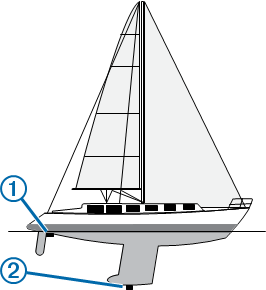
 sets the alarm to sound when fish of all sizes are detected.
sets the alarm to sound when fish of all sizes are detected. sets the alarm to sound only when medium or large fish are detected.
sets the alarm to sound only when medium or large fish are detected. sets the alarm to sound only when large fish are detected.
sets the alarm to sound only when large fish are detected.















Need help?
Do you have a question about the striker 4 and is the answer not in the manual?
Questions and answers